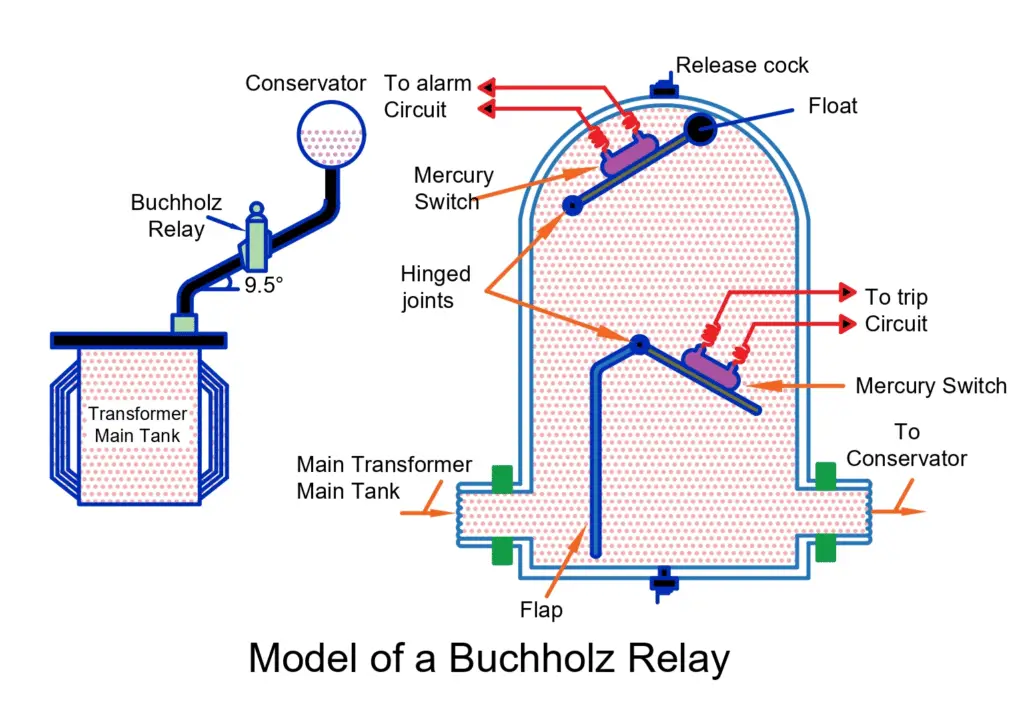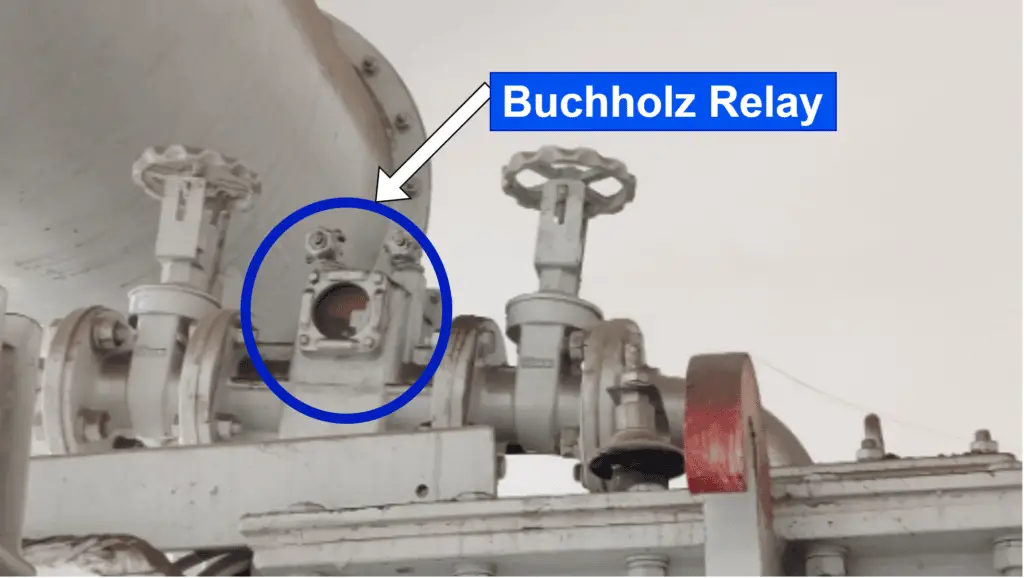Buchholz relay, like any other relay, is a sensing device used to sense abnormal working of a transformer in a critical operation like a power transformer. It was devised in the year 1921 by Max Buchholz, hence the name. Sensing abnormality is important so that based on that feedback, some corrective or preventive action can be taken and the effect of the fault is not spread across the entire power system.
A Buchholz relay is employed in an oil-immersed transformer as it is an oil-activated relay. High-power transformers like those in power stations are subjected to high load current causing an equivalent rise in temperature. Thus it is important to cool it down for its normal operation and that’s why the core of these transformers is immersed in oil.
The oil absorbs the heat from the core and releases it into the atmosphere as the air passes. However, during an abnormal situation like short-circuit and overheating of the transformer or if the oil is leaking out, the Buchholz relay activates to protect the transformer and the entire power system from any spill-over effect.
Working principle of Buchholz relay
Unlike other relays that are electrically or electronically operated, the Buchholz relay is mechanically operated and an efficient relay system. It mainly consists of two parts – The Float hinged at the top and the flap hinged at the bottom near the transformer’s main tank as shown in the picture below.

Buchholz relay provides protection against short-circuiting, overheating, and oil leakage in a transformer.
When the transformer is highly loaded, it causes overheating of the transformer. Continuous operation of the transformer at such a rising temperature may damage it. That’s where the Buchholz relay comes to the rescue.

Due to overheating of the windings, more insulating oil is required by the transformer to cool down. This oil eventually evaporates in the form of Carbon-Mono-Oxide, Carbon-Di-Oxide, and other hydrocarbon gases. This causes a drop in the level of the transformer oil in which the core of the transformer has been immersed. With the drop in the level of the oil, the floating plate hinged at the top also lowers down.
A mercury switch is attached to the float plate at the top. This switch is nothing but a simple two-terminal device containing mercury. These two terminals are connected to an alarm circuit. When the float plate goes down due to the lowering of the oil level in the transformer, the liquid mercury inside the switch causes both terminals to short. As the terminals are connected to an alarm circuit, shortening causes the alarm to activate.
In this way, the operator of the transformer is alerted about the overheating problem of the transformer. The operator thus opens the release cock at the top of the relay to collect the accumulated gases due to oil evaporation. Based on that, he/she can decide on the corrective action.
In case of leakage of oil too, the oil level falls down. This may cause the transformer temperature to shoot up even though it is operating under normal conditions with normal parameters.
The leakage of oil causes the oil level in the transformer to fall abruptly. This causes the floating plate to lower down and the mercury switch activates the alarm circuit to alert the operator.
It must be noted that in case of overheating or in case of oil leakage, the relay raises an alarm instead of shutting down the transformer. While in the case of short-circuit, the Buchholz relay sends a trip signal to the circuit breaker causing the transformer operation to stop.

This is because in the case of overheating or oil leakage, there is a potential chance of a problem or it might be that the transformer is undergoing some maintenance or test.
But in case of short-circuit, immediate prompt action is of utmost importance and priority. That’s why the relay directly sends a trip voltage to the circuit breaker. Let’s understand how the relay works against a short-circuit fault.
Short-circuit fault can happen when the load connected to the transformer draws a short-circuit current or if there is an inter-turn short-circuit within the transformer due to insulation breakdown. In both cases, the windings of the transformer are subjected to huge electrical stress and hence the temperature of the transformer begins to rise enormously. This rise in temperature is higher than the cooling effect of the oil.
Therefore, more oil is evaporated instantly in the process of cooling down the transformer and hence more oil enters from the main tank towards the transformer.
As the oil inside the transformer evaporates at a rapid rate, the one entering through the main tank enters rapidly as well. Hence the force of this oil from the main tank causes the flap to move forward. The flap is hinged with another plate carrying a mercury switch (as shown in the picture above). As the flap moves forward, the plate attached to the mercury switch moves upward. This causes the mercury inside the switch to displace and it connects the two terminals of the switch.
The terminals are connected to a trip circuit externally and as the circuit gets completed by the mercury within the switch, it causes the trip circuit to activate. This trip circuit activates a circuit breaker which disconnects the transformer from the entire power system. In this way, the Buchholz relay protects the transformer in case of a short-circuit fault or an inter-turn fault.
In this case, no alarm is raised but the relay acts as a protection device itself.
Advantages of Buchholz relay
- Simple construction and working without the need for any external electrical power as it operates mechanically.
- The relay separates the overloading fault from short-circuit and inter-turn fault. In case of overloading, the relay activates an alarm while in case of short-circuit it takes swift action by activating a trip circuit.
- Low maintenance is required.
Disadvantages of Buchholz relay
- This relay works only in the case of an oil-immersed transformer.
- It relies on the oil level strictly to function instead of the actual circuit itself. Thus it doesn’t stop the fault before it reaches the transformer. It only activates when the fault reaches the transformer.
- The response time of the relay is very high compared to other relays. It takes about 0.1s to activate.
- The relay doesn’t guard the connecting cables, so separate protection is required.
Testing of Buchholz Relay
There are different types of testing techniques for a Buchholz Relay.
- Electrical Test
The earthing insulation is subjected to about 2000V for 1 minute to test the insulation strength.
- Leakage Test
The Buchholz relay is filled with oil and is subjected to a temperature of 90 degree Celsius. The leakage rate is tested after 30 minutes.
- Functional Test
The testing of the Buchholz relay can be done on a specially designed PLC-controlled testing unit. Under this test, the response from various contact points within the relay is recorded and tested.
Precautions required with Buchholz relay
The Buchholz relay may activate a false alarm or trip signal even if there is no actual fault. For example, when the oil is added to the transformer through the main tank during normal operation, air may get into it along with the oil. This air gets accumulated under the relay cover and may cause the relay to trigger an alarm.
That’s why a mechanical locking system is provided in the relay so that the mercury switches could be locked when the oil is being added to the transformer.
The lower float plate can also move forward even during normal oil intake by the transformer thus causing the trip circuit to activate. This can happen due to loose or inaccurate hinges. Hence, proper maintenance is required at times.